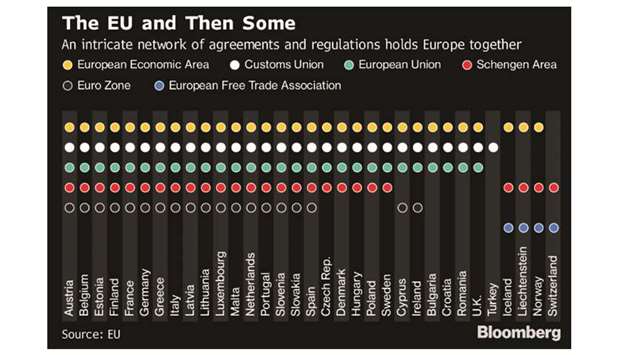Prime Minister Theresa May’s proposed Brexit deal with the European Union raises the prospect of the UK remaining in some kind of customs union with the bloc, perhaps indefinitely. It wasn’t the government’s original plan and it’s still not officially the long-term goal. But there’s evidence that’s where the deal leads. Such an arrangement would keep goods in European supply chains moving tariff-free in and out of the UK, averting some of the most destabilising disruptions to business and borders when Britain leaves the EU. It also risks undercutting some of the key aims of Brexit, making the deal a hard sell for some British politicians.
1. What’s a customs union?
It’s an agreement among a group of countries for goods to move freely among them, without tariffs. Those members agree to align certain regulations and impose the same “external” tariffs on goods imported from nations that aren’t a part of the union. That way, once goods enter the bloc, they can move freely without further checks. The setup greases trade flows and provides leverage in negotiating trade deals with the rest of the world.
2. Who is in the EU customs union now?
All 28 countries of the EU – which includes the UK until next March – are automatically members. Some other nations, notably Turkey which struck a special deal with the EU in 1996, also take part. While there would be differences between the UK’s relationship with the EU and Turkey’s, the UK would essentially be following the Turkish model – at least temporarily – in being inside the customs union but outside the EU’s single market.
3. What has Turkey’s experience been?
Its customs union arrangement allows for tariff-free trade with EU nations in industrial goods but excludes other areas such as agriculture. Since it’s not a member of the single market, Turkey diverges in standards and regulations, making frictionless trade impossible. Turkey must abide by the trade deals the EU strikes with other countries. Dissatisfaction with that arrangement has grown in Turkey, where there are traffic jams at the border (due to the need for permits) and chafing at having to follow what the EU decides.
4. What’s the case for the UK being in a customs union?
The UK Treasury warned before the 2016 Brexit referendum that leaving the customs union would mean the imposition of “significant” administrative costs, such as border checks and certification of where goods come from. Staying in might avert disruptions to cross-border trade that’s crucial to the automotive and other industries. Many officials on the EU side of the negotiations always believed - and hoped - that a customs union would be part of the Brexit outcome. The opposition Labour party’s position is for the UK to be a permanent member of the customs union.
5. What do opponents say?
A key part of the campaign narrative for Brexit was that Britain would go out in the world and forge its own trade agreements, and a customs union makes that impossible. The UK would be subject to trade accords on goods the bloc strikes with other countries while having little or no say in negotiating them. It could mean having to open the UK’s markets unilaterally to countries that strike trade deals with the bloc, without getting reciprocal access. Nor could the UK on its own remove tariffs on goods coming in from third countries, which some Brexit supporters want to do to reduce prices.
6. Does a customs union enable ‘frictionless trade’?
No. The term refers to an aspiration by the UK that trade with the EU would remain seamless after Brexit. The EU says this is impossible. The UK will push for trade to be as frictionless as possible in talks on future ties that start as soon as the country leaves the bloc in March 2019.
7. How did it come to this?
British and European negotiators arrived at this solution as a way of averting a hard border between Northern Ireland and the Republic of Ireland, which will become the post-Brexit dividing line between the EU and the UK. After a 21-month transition period (in which Britain will stick to the EU’s customs union and single market rules), the country will remain in what the draft agreement describes as a “single customs territory” with the bloc. (This agreement on the Irish border is what’s known as “the backstop”.) It’s meant to be temporary, lasting only until the two sides work out other arrangements to avoid checks at the border, which could emerge as part of talks on a full trade deal, to take place during the transition period. The trouble is, there’s little agreement about what the solution could be, and it may have to involve technology that isn’t even invented yet.
8. What happens after the
transition period?
For one thing, the transition could be extended by up to another two years as long as both sides agree. After that, the backstop would be triggered. The UK could leave this arrangement only when the EU agrees that a better solution has been found. In addition to the shared customs area, the UK would stay aligned with some EU rules in areas such as standards for goods, state aid, competition and social and environmental policy, a position some British politicians say makes the country a “rule-taker” after it leaves the EU. Northern Ireland would have a deeper customs relationship with the EU than the rest of the UK and would be more closely aligned with the EU’s single-market rules.

Graph
